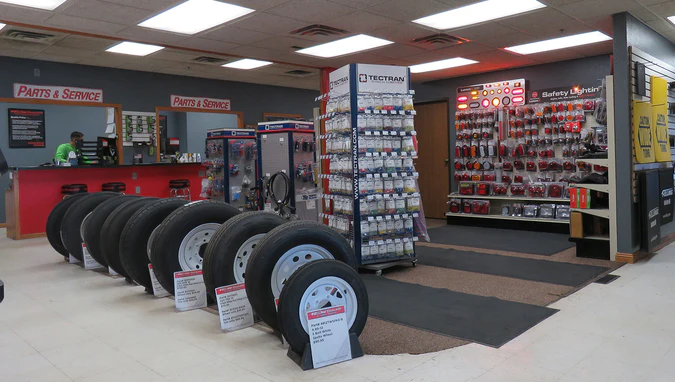Trailers are built to handle tough jobs, but even the most reliable equipment can face occasional hiccups. Knowing how to troubleshoot common trailer problems not only saves you time but also keeps your towing experience safe and hassle-free. Here are some of the most frequent issues trailer owners face—and how to fix them.
1. Brake Issues
If you are experiencing reduced stopping power, squealing brakes, or brakes not engaging, you are likely facing a brake issue that should be addressed immediately. Brake problems often stem from worn pads, faulty connections, or an uncalibrated brake controller. To verify the issue, follow these troubleshooting tips or bring your trailer to a registered mechanic for further repairs.
Brake Troubleshooting Tips:
- Inspect the brake pads and replace them if worn.
- Check the brake controller settings and wiring connections.
- Test the trailer’s emergency breakaway system to ensure it’s functioning properly.
Pro Tip: Regularly inspect your trailer’s braking system, especially before long trips, to avoid unexpected failures.
2. Electrical Problems (Lights Not Working)
Electrical troubles can become a serious hazard on the road. If your trailer lights are not functioning properly, you may not be able to signal to other drivers when turning or slowing down. At night, poor lighting can make your trailer nearly invisible until it’s too late. Symptoms of electrical problems include dim trailer lights, flickering lights, or lights that are completely out. Common causes include loose wiring, corroded connectors, or a blown fuse. Use the following troubleshooting tips to pinpoint the issue.
Electrical Troubleshooting Tips:
- Test the tow vehicle’s wiring harness and trailer plug with a multimeter to identify any faults.
- Clean corroded connectors with a wire brush or replace them if necessary.
- Check the fuses in your vehicle and replace any that are blown.
Pro Tip: Use dielectric grease on connectors to prevent corrosion and ensure a solid electrical connection.
3. Tire Problems
Trailer tires endure significant wear, whether from heavy loads or long distances traveled. Symptoms of tire problems include flat tires, uneven wear, or excessive wobbling while towing. Common causes include under-inflation, overloading, or misaligned axles. Use the following troubleshooting tips to address these issues.
Troubleshooting Tips:
- Use a tire pressure gauge to ensure proper inflation according to the trailer’s recommended PSI.
- Inspect for signs of damage or excessive wear on tires and replace them as needed.
- Rotate tires periodically to ensure even wear and extend their lifespan.
Pro Tip: Always carry a spare tire and a tire-changing kit to avoid being stranded on the road.
4. Hitch and Coupler Issues
Is your trailer having trouble connecting or staying connected? This may be due to a hitch or coupler issue. Common causes include using an improperly sized hitch ball, a worn coupler, or inadequate lubrication. Use the following troubleshooting tips to identify and resolve the issue.
Troubleshooting Tips:
- Verify that the hitch ball size matches the coupler size.
- Check for wear or cracks in the coupler and replace it if needed.
- Lubricate the hitch and coupler to prevent sticking and ensure a smooth connection.
Pro Tip: Double-check the connection before every trip to ensure the coupler is securely latched.
5. Uneven Weight Distribution
Proper weight distribution is critical to avoid harm to your trailer, your vehicle, or others on the road. Improper weight distribution can be dangerous and should be addressed immediately. Symptoms include trailer swaying or difficulty steering while towing. Check the placement of items on your trailer and ensure the weight is evenly distributed. Follow these tips to maintain proper weight balance.
Troubleshooting Tips:
- Place heavier items over the axle and distribute the weight evenly side-to-side.
- Ensure you’re not exceeding the trailer’s Gross Vehicle Weight Rating (GVWR).
- Use a weight distribution hitch for added stability if needed.
Pro Tip: Follow the 60/40 rule: 60% of the weight should be in the front half of the trailer, 40% in the rear.
Bonus Tips for Preventative Maintenance
- Keep a basic tool kit, spare parts, and a tire repair kit in your vehicle for emergencies.
- Perform a pre-trip inspection focusing on tires, lights, brakes, and the hitch system.
- Stick to a regular maintenance schedule, including cleaning and lubricating moving parts.
Stay Safe and Road-Ready

By knowing how to troubleshoot common trailer problems, you can keep your trailer in top condition and avoid unexpected setbacks. Proactive maintenance not only saves you time and money but also ensures your safety on the road. If you’re ever unsure or need professional guidance, don’t hesitate to reach out to our team for expert assistance and quality parts.
Need professional assistance or high-quality replacement parts? Call 1-866-335-5464 to talk with our team, or visit our parts store for parts you can trust. With proper care and attention, your trailer will continue to perform at its best for years to come.


